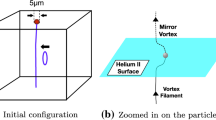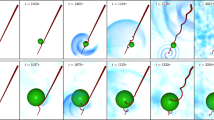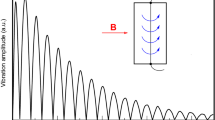Abstract
Massive enough particles of frozen hydrogen are known to be captured by quantum vortices in liquid helium. Here, we theoretically demonstrate that the drift of such particles along the vortex is limited by the friction force, which was explicitly calculated. Our hypothesis explains the stabilization of the micron-sized particles’ position on the axis of the vertical vortices despite the significant buoyant force promoting the floating up of the particles.
Similar content being viewed by others
References
G.P. Bewley, D.P. Lathrop, K.R. Sreenivasan, Visualization of quantized vortices. Nature 441, 588 (2006). https://doi.org/10.1038/441588a
G.P. Bewley, Using frozen hydrogen particles to observe rotating and quantized flows in liquid helium. Ph.D. thesis, Yale University (2006)
E.M. Lifshitz, L. Pitaevskii, Statistical Physics. Theory of the Condensed State (Butterworth-Heinemann, Oxford, UK), Course of Theoretical Physics, vol. 9, 1st edn., chap. III, pp. 85–140 (1980)
V. Tkachenko, On vortex lattices. J. Exp. Theor. Phys. 22(6), 1282 (1966)
R.P. Feynman, Statistical Mechanics: A Set of Lectures (Taylor & Fransis Group, New York, USA), chap. 11.8: Superfluidity. Rotation of the Superfluid, pp. 337–338 (2018)
G.P. Bewley, K. Sreenivasan, D.P. Lathrop, Particles for tracing turbulent liquid helium. Exp. Fluids 44(6), 887 (2008). https://doi.org/10.1007/s00348-007-0444-6
T. Chagovets, S. van Sciver, A study of thermal counterflow using particle tracking velocimetry. Phys. Fluids 23(10), 107102 (2011). https://doi.org/10.1063/1.3657084
Y. Mineda, M. Tsubota, Y. Sergeev, C. Barenghi, W. Vinen, Velocity distributions of tracer particles in thermal counterflow in superfluid \(^4\text{ He }\). Phys. Rev. B 87, 174508 (2013). https://doi.org/10.1103/PhysRevB.87.174508
C.F. Barenghi, Y.A. Sergeev, Motion of vortex ring with tracer particles in superfluid helium. Phys. Rev. B 80(2), 024514 (2009). https://doi.org/10.1103/PhysRevB.80.024514
D.P. Meichle, Characterization of quantum vortex dynamics in superfluid helium. Ph.D. thesis, University of Maryland (2015)
J.S. Brooks, R.J. Donnelly, The calculated thermodynamic properties of superfluid heliumm-4. J. Phys. Chem. Ref. Data 6(1), 51 (1977). https://doi.org/10.1063/1.555549
H.D. Megaw, The density and compressibility of solid hydrogen and deuterium at \(4\cdot 2^\circ \,\text{ k }\). Lond. Edinburgh Dublin Philos. Mag. J. Sci. 28(187), 129 (1939). https://doi.org/10.1080/14786443908521169
S. Purushothaman, Superfluid helium and cryogenic noble gases as stopping media for ion catchers. Ph.D. thesis, University of Groningen (1978)
E. Yarmchuk, M. Gordon, R. Packard, Observation of stationary vortex arrays in rotating superfluid helium. Phys. Rev. Lett. 43(3), 214 (1979). https://doi.org/10.1103/PhysRevLett.43.214
W. Guo, H.J. Maris, Observations of the motion of single electrons in liquid helium. J. Low Temp. Phys. 148(3–4), 199 (2007). https://doi.org/10.1007/s10909-007-9373-2
H. Goldstein, Classical Mechanics (Addison-Wesley, Reading, Massachusetts, USA), chap. 12–7: Noether’s theorem, pp. 588–596 (1980)
N.G. Berloff, P.H. Roberts, Motion in a bose condensate: VIII. Electron Bubble J. Phys. A 34(1), 81 (2001). https://doi.org/10.1088/0305-4470/34/1/306
D. Jin, H. Maris, A study of the motion of particles in superfluid helium-4 and interactions with vortices. J. Low Temp. Phys. 162(3–4), 329 (2011). https://doi.org/10.1007/s10909-010-0237-9
L.D. Landau, E. M.Lifshitz, Fluid Mechanics (Pergamon Press, Oxford, UK), Course of Theoretical Physics, vol. 6, 2nd edn., chap. II–IV, pp. 44–191 (1987)
N. Simakov, Calculation of the flow about a sphere and the drag of the sphere under laminar and strongly turbulent conditions. Tech. Phys. 58(4), 481 (2013). https://doi.org/10.1134/S1063784213040233
Acknowledgements
The work was completed as a part of the state assignment~(theme number AAAA-A20-120013190076-0).
Author information
Authors and Affiliations
Corresponding author
Additional information
Publisher's Note
Springer Nature remains neutral with regard to jurisdictional claims in published maps and institutional affiliations.
Appendix
Appendix
Let us estimate the hydrodynamic force acting between two particles of a diameter d captured by a quantum vortex and separated by the distance \({\bar{R}}\). Let the origin of coordinates be placed on the vortex axis and coincide with the position of the first particle, and let the applicate axis to be directed upwards along the vortex axis. Vector \({\bar{k}}\) would be the unit vector along the applicate. Let us denote the coordinate in the proximity of the first particle would be \({\bar{x}}\), while in the vicinity of the second particle – \({\bar{R}} + {\bar{y}}\). The influence of the first particle on the velocity field in the vortex (far from the first particle) can be modeled by the deformation of the vertical axis of the initial vortex I (Fig. 1). Let us approximate the deformed vortex II by the sum of the initial vortex I and the vortex defined on some closed contour (Fig. 1). The diameter of the contour L should be about the particle’s diameter d by order of magnitude. Therefore, the correction for the velocity field (\(\delta {\bar{V}}\)) related to the vortex axis deformation could be assessed as the closed-contour integral [3]:
Let us introduce the normalized variables \({\bar{x}}' = {\bar{x}}/d\) and \({\bar{y}}' = {\bar{y}}/d\), so \(|{\bar{x}}'| \sim 1\) and \(|{\bar{y}}'| \sim 1\). The ratio of \(d/R = \varepsilon \ll 1\). So, the integral (A1) could be presented as a contour integral in normalized coordinates per the contour \(L' = L/d\) having a diameter of about a unity:
Taking into account the equality to the zero of the circulation of \(d{\bar{x}}'\), and making the Taylor linearization of the expression (A2) results in the reduced linear expression for \(\delta {\bar{V}}\):
where
So, the main part of the correction to the velocity field ((A3) and (A4)) does not depend on \({\bar{y}}'\).
Let us denote the velocity vector around the initial vortex I as \({\bar{U}}\). In the point of the second particle, its components could be represented as:
Here we have defined the components of the coordinate vector \({\bar{y}}\) to be equal: \(y_1 = r\cos \theta\), \(y_2 = r\sin \theta\), \(y_3 = z\), where r, \(\theta\), and z – are the components of the cylindrical coordinate system. \(r' = r/d\) and \(z' = z/d\) so \(|r'| \sim |z'| \sim 1\) in the vicinity of the second particle. Neglecting the disturbance of the velocity field by the second particle, the affinity energy of the second particle and the vortex (E) could be estimated as:
where V—is the volume of the second particle, while \(V'\)—is the same volume in the normalized coordinates (so, its diameter would be also \(\sim 1\)). Therefore, the energy of the hydrodynamic influence of the first particle on the second one can be assessed as:
where
The correction to the affinity of the first particle to the vortex due to the presence of the second particle could be calculated in the same way, only \(\varGamma\) would differ (but also would be close to unity). The Sum of these two values is the energy of the hydrodynamic interaction of two particles captured by the quantum vortex. It also has a form of the expression (A7) with some \(\varGamma \sim 1\). Differentiation of the expression (A7) allows calculating the magnitude of the hydrodynamic force between the particles:
This expression appeared in the main text of the work as (5). In the case of the symmetrical particle, the integrals (A8) would zero out. So, the calculation of the hydrodynamic force would require to account for the non-linear terms in (A2). As the parameter \(\varepsilon = d/R\) is small, the non-linear terms of the Taylor series would be lower than the obtained linear estimate for irregular-shaped particle (5).
Rights and permissions
About this article
Cite this article
Skoblin, A.A., Zlenko, D.V. & Stovbun, S.V. Friction Force Limits the Drift of Microparticles Along the Quantum Vortex in Liquid Helium. J Low Temp Phys 200, 91–101 (2020). https://doi.org/10.1007/s10909-020-02485-4
Received:
Accepted:
Published:
Issue Date:
DOI: https://doi.org/10.1007/s10909-020-02485-4





